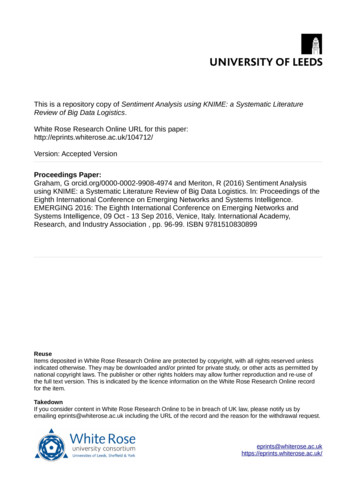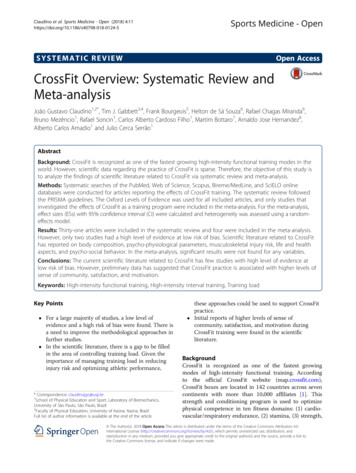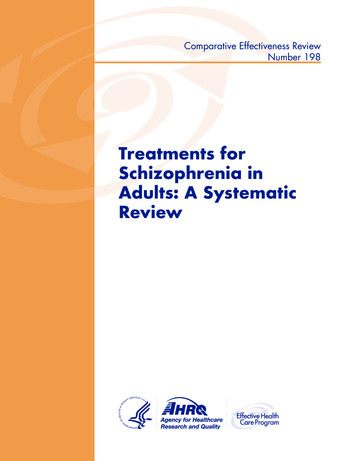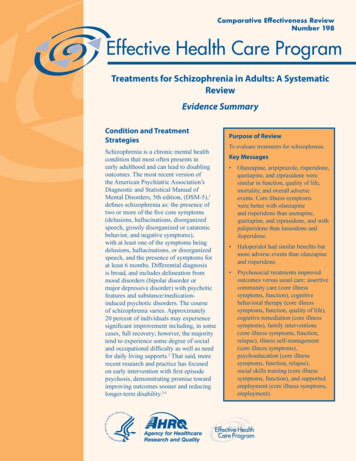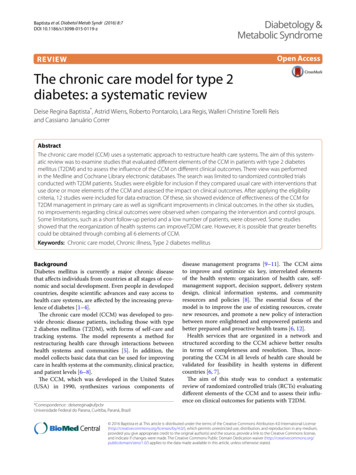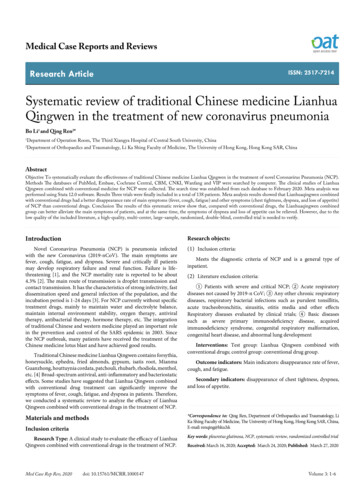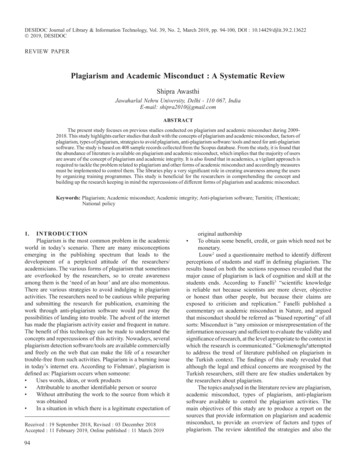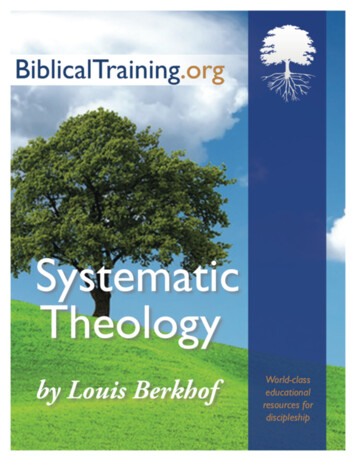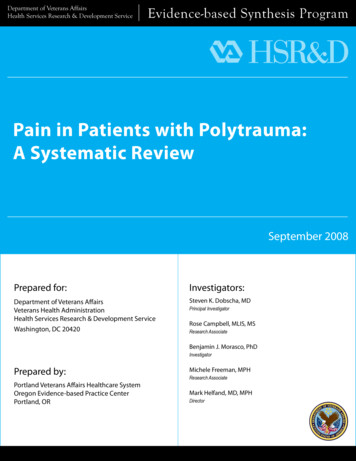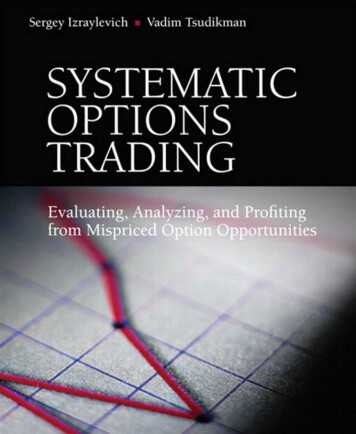
Transcription
SystematicOptions Trading
This page intentionally left blank
SystematicOptionsTradingEvaluating, Analyzing, and Profiting fromMispriced Option OpportunitiesSergey Izraylevich andVadim Tsudikman
Vice President, Publisher: Tim MooreAssociate Publisher and Director of Marketing: Amy NeidlingerExecutive Editor: Jim BoydEditorial Assistant: Pamela BolandOperations Manager: Gina KanouseSenior Marketing Manager: Julie PhiferPublicity Manager: Laura CzajaAssistant Marketing Manager: Megan ColvinCover Designer: Gary AdairManaging Editor: Kristy HartProject Editors: Jovana San Nicolas-Shirley and Andy BeasterCopy Editor: Apostrophe Editing ServicesProofreader: Williams Woods Publishing ServicesIndexer: Word Wise Publishing SrevicesSenior Compositor: Gloria SchurickManufacturing Buyer: Dan Uhrig 2011 by Pearson Education, Inc.Publishing as FT PressUpper Saddle River, New Jersey 07458This book is sold with the understanding that neither the authors nor the publisher is engaged in rendering legal, accounting, or otherprofessional services or advice by publishing this book. Each individual situation is unique. Thus, if legal or financial advice or otherexpert assistance is required in a specific situation, the services of a competent professional should be sought to ensure that the situationhas been evaluated carefully and appropriately. The author and the publisher disclaim any liability, loss, or risk resulting directly orindirectly, from the use or application of any of the contents of this book.FT Press offers excellent discounts on this book when ordered in quantity for bulk purchases or special sales. For more information, please contact U.S. Corporateand Government Sales, 1-800-382-3419, corpsales@pearsontechgroup.com. For sales outside the U.S., please contact International Sales atinternational@pearson.com.Company and product names mentioned herein are the trademarks or registered trademarks of their respective owners.All rights reserved. No part of this book may be reproduced, in any form or by any means, without permission in writing from the publisher.Printed in the United States of AmericaFirst Printing September 2010ISBN-10: 0-13-708549-4ISBN-13: 978-0-13-708549-1Pearson Education LTD.Pearson Education Australia PTY, Limited.Pearson Education Singapore, Pte. Ltd.Pearson Education North Asia, Ltd.Pearson Education Canada, Ltd.Pearson Educatión de Mexico, S.A. de C.V.Pearson Education—JapanPearson Education Malaysia, Pte. Ltd.Library of Congress Cataloging-in-Publication DataIzraylevich, Sergey, 1966Systematic options trading : evaluating, analyzing, and profiting from mispriced option opportunities / Sergey Izraylevich and Vadim Tsudikman.p. cm.ISBN-13: 978-0-13-708549-1 (hardback : alk. paper)ISBN-10: 0-13-708549-41. Stock options. 2. Options (Finance) 3. Investment analysis. 4. Portfolio management. I. Tsudikman, Vadim, 1965- II. Title.HG6042.I97 2011332.63’2283—dc222010006153
This book is dedicated to Professor Uri Gerson, Hebrew University of Jerusalem.
This page intentionally left blank
ContentsIntroduction . . . . . . . . . . . . . . . . . . . . . . . . . . . . . . . . xvPART Ichapter 1Criteria as the Basis of a Systematic ApproachGeneral Presentation and Review of Criteria Properties . . . 31.1 The Main Tool for Solving the Selection Problem . . . 31.2 Formal Definition . . . . . . . . . . . . . . . . . . . . . . . . . . . 41.3 Philosophy of Criteria Creation . . . . . . . . . . . . . . . . . 51.4 Mission Fulfilled by Criteria . . . . . . . . . . . . . . . . . . . . 61.5 Forecast as a Key Element of the Criterion . . . . . . . . . 81.6 Classification of Criteria . . . . . . . . . . . . . . . . . . . . . . . 91.6.1 Universal Criteria . . . . . . . . . . . . . . . . . . . . . . . . 91.6.2 Specific (Nonuniversal) Criteria . . . . . . . . . . . . 11chapter 2Review of the Main Criteria . . . . . . . . . . . . . . . . . . . . . 132.1 Criteria Based on Lognormal Distribution . . . . . . . . 132.1.1 Description of Lognormal Distribution. . . . . . 132.1.2 Expected Profit on the Basis of LognormalDistribution . . . . . . . . . . . . . . . . . . . . . . . . . . . . . . 152.1.3 Profit Probability on the Basis of LognormalDistribution . . . . . . . . . . . . . . . . . . . . . . . . . . . . . . 202.2 Criteria Based on Empirical Distribution . . . . . . . . . 222.2.1 Description of Empirical Distribution . . . . . . . . 222.2.2 Expected Profit on the Basis of EmpiricalDistribution . . . . . . . . . . . . . . . . . . . . . . . . . . . . . . 252.2.3 Profit Probability on the Basis of EmpiricalDistribution . . . . . . . . . . . . . . . . . . . . . . . . . . . . . . 28
viiiSystematic Options Trading2.2.4 Simplified Calculation Algorithm . . . . . . . . . . . 282.2.5 Modifications of Empirical Distribution . . . . . . 312.3 Criteria Based on the Ratio of ExpectedProfit to Loss . . . . . . . . . . . . . . . . . . . . . . . . . . . . . . . 342.3.1 Basic Concept and Criteria CalculationMethod . . . . . . . . . . . . . . . . . . . . . . . . . . . . . . . . . 342.3.2 Criteria Calculation Example . . . . . . . . . . . . . . 362.4 Criteria Based on Expert Distribution . . . . . . . . . . . 382.4.1 Basic Concept and Criteria CalculationMethod . . . . . . . . . . . . . . . . . . . . . . . . . . . . . . . . . 382.4.2 Set of Standard Distributions . . . . . . . . . . . . . . 392.4.3 Combining Separate Standard Distributionsinto a Unified Probability Density Function . . . . . . 452.4.4 Criteria Calculation on the Basis of the UnifiedProbability Density Function . . . . . . . . . . . . . . . . . 472.4.5 Construction and Valuation of ComplexStrategies Based on the Unified ProbabilityDensity Function . . . . . . . . . . . . . . . . . . . . . . . . . . 482.5 Specific (Nonuniversal) Criteria . . . . . . . . . . . . . . . . 502.5.1 Break-Even Range . . . . . . . . . . . . . . . . . . . . . . . 502.5.2 IV/HV Ratio . . . . . . . . . . . . . . . . . . . . . . . . . . . 532.5.3 Relative Frequency Criterion . . . . . . . . . . . . . . 572.5.4 The Ratio of Normalized Time Value to theCoefficient of Absolute Price ChangesDistribution . . . . . . . . . . . . . . . . . . . . . . . . . . . . . 58chapter 3Evaluation of Criteria Effectiveness . . . . . . . . . . . . . . . . 633.1 Introduction . . . . . . . . . . . . . . . . . . . . . . . . . . . . . . . 633.2 Methods of Criteria Effectiveness Evaluation . . . . . . 643.2.1 Correlation Between a Criterion andProfit as the Main Effectiveness Indicator . . . . . . . 643.2.2 Transformation of the Criteria EffectivenessIndicator . . . . . . . . . . . . . . . . . . . . . . . . . . . . . . . . 683.2.3 The Dynamics of Transformed EffectivenessIndicators . . . . . . . . . . . . . . . . . . . . . . . . . . . . . . . 693.2.4. Selection of the Averaging Period . . . . . . . . . . . 72
Contentsix3.3 Peculiarities of Criteria Effectiveness Evaluation . . . 753.3.1 Number of Combinations Used inthe Analysis . . . . . . . . . . . . . . . . . . . . . . . . . . . . . . 753.3.2 Expressing Profit . . . . . . . . . . . . . . . . . . . . . . . . 773.3.3 Expressing Effectiveness Indicators. . . . . . . . . 803.4 Review of Criteria Effectiveness Indicators . . . . . . . . 843.4.1 Correlation Between Criterion andProfit Values . . . . . . . . . . . . . . . . . . . . . . . . . . . . . 853.4.2 Correlation Between a Criterion andProfit Indexes . . . . . . . . . . . . . . . . . . . . . . . . . . . . 863.4.3 Correlation Between the Sharpe Ratios ofCriterion and Profit . . . . . . . . . . . . . . . . . . . . . . . . 883.4.4 Areas Ratio . . . . . . . . . . . . . . . . . . . . . . . . . . . . 913.4.5 Other Effectiveness Indicators . . . . . . . . . . . . . . 963.5 Summary . . . . . . . . . . . . . . . . . . . . . . . . . . . . . . . . 102PART IIchapter 4The Main Areas of Criteria ApplicationSelection of Option Combinations . . . . . . . . . . . . . . . . 1054.1 Introduction . . . . . . . . . . . . . . . . . . . . . . . . . . . . . . 1054.2 Analysis of Criteria Effectiveness in the Selectionof Option Combinations . . . . . . . . . . . . . . . . . . . . . 1064.3 Factors That Affect Option CombinationsSelection . . . . . . . . . . . . . . . . . . . . . . . . . . . . . . . . . 1104.3.1 Absolute Values of the Criterion . . . . . . . . . . . 1104.3.2 Strategy and Underlying Assets . . . . . . . . . . . . 1124.3.3 Simultaneous Analysis of Factors AffectingCombinations Selection . . . . . . . . . . . . . . . . . . . . 1134.4 Multistrategy, Long-Term Evaluation of CriteriaEffectiveness . . . . . . . . . . . . . . . . . . . . . . . . . . . . . . 1154.4.1 Methods . . . . . . . . . . . . . . . . . . . . . . . . . . . . . 1154.4.2 Results . . . . . . . . . . . . . . . . . . . . . . . . . . . . . . 1164.5 Summary . . . . . . . . . . . . . . . . . . . . . . . . . . . . . . . . 119chapter 5Selection of Option Strategies . . . . . . . . . . . . . . . . . . 1215.1 Introduction . . . . . . . . . . . . . . . . . . . . . . . . . . . . . . 1215.2 Evaluation of Criterion Effectiveness by RankingAnalysis . . . . . . . . . . . . . . . . . . . . . . . . . . . . . . . . . . 123
xSystematic Options Trading5.2.1 Methods of Ranking Analysis . . . . . . . . . . . . . 1235.2.2 Results of Ranking Analysis . . . . . . . . . . . . . . . 1315.2.3 Generalized Ranking Analysis andIntroduction of the Threshold Parameter . . . . . . . 1395.2.4 Results of Generalized Ranking Analysis . . . . . 1405.2.5 Maximum Obtainable Values of theCriterion Effectiveness Coefficient . . . . . . . . . . . . 1425.3 Traditional Methods of Evaluating the CriterionEffectiveness . . . . . . . . . . . . . . . . . . . . . . . . . . . . . . 1455.4 Synthetic Approach to Criterion EffectivenessAnalysis . . . . . . . . . . . . . . . . . . . . . . . . . . . . . . . . . . 1505.5 The Model for Optimizing the ThresholdParameter . . . . . . . . . . . . . . . . . . . . . . . . . . . . . . . . 1555.6 Summary . . . . . . . . . . . . . . . . . . . . . . . . . . . . . . . . 159chapter 6Selection of Underlying Assets . . . . . . . . . . . . . . . . . . 1616.1 Introduction . . . . . . . . . . . . . . . . . . . . . . . . . . . . . . 1616.2 Analysis of Criteria Effectiveness in Selectionof Underlying Assets . . . . . . . . . . . . . . . . . . . . . . . . . 1626.3 Multistrategy, Long-Term Evaluation ofCriteria Effectiveness . . . . . . . . . . . . . . . . . . . . . . . 1666.3.1 Methods . . . . . . . . . . . . . . . . . . . . . . . . . . . . . 1666.3.2 Results . . . . . . . . . . . . . . . . . . . . . . . . . . . . . . 1676.4 The Optimization Model for the Number ofUnderlying Assets . . . . . . . . . . . . . . . . . . . . . . . . . . . 1686.4.1 Utility Indicators . . . . . . . . . . . . . . . . . . . . . . . 1696.4.2 Utility Functions . . . . . . . . . . . . . . . . . . . . . . . 1716.4.3 Convolution of Utility Functions and DerivingOptima for Different Strategies and Criteria . . . . 1736.5 Summary . . . . . . . . . . . . . . . . . . . . . . . . . . . . . . . . 176
ContentsPART IIIchapter 7xiMulticriteria AnalysisBasic Concepts of Multicriteria Selection asApplied to Options . . . . . . . . . . . . . . . . . . . . . . . . . . 1817.1 Introduction . . . . . . . . . . . . . . . . . . . . . . . . . . . . . . 1817.2 The Pareto Set . . . . . . . . . . . . . . . . . . . . . . . . . . . . 1837.2.1 The Algorithm of Forming the Pareto Set. . . 1837.2.2 Widening the Pareto Set and the “Layer”Notion . . . . . . . . . . . . . . . . . . . . . . . . . . . . . . . . . 1867.3 Convolution . . . . . . . . . . . . . . . . . . . . . . . . . . . . . . 1907.4 Comparative Analysis of Multicriteria andMonocriterion Selection Effectiveness . . . . . . . . . . . 1917.5 Comparative Analysis of Two MulticriteriaSelection Methods: Pareto Versus Convolution . . . . 1977.6 Summary . . . . . . . . . . . . . . . . . . . . . . . . . . . . . . . . 202chapter 8The Impact of Criteria Correlation on MulticriteriaSelection . . . . . . . . . . . . . . . . . . . . . . . . . . . . . . . . 2058.1 Introduction . . . . . . . . . . . . . . . . . . . . . . . . . . . . . . 2058.2 Evaluation of Criteria Interrelationship . . . . . . . . . 2068.3 Criteria Correlation and Profitability of ParetoSelection . . . . . . . . . . . . . . . . . . . . . . . . . . . . . . . . . 2088.4 Criteria Correlation and Profitability ofSelection Using the Convolution Method . . . . . . . . . 2128.5 Summary . . . . . . . . . . . . . . . . . . . . . . . . . . . . . . . . 214Conclusion . . . . . . . . . . . . . . . . . . . . . . . . . . . . . . . 217Bibliography . . . . . . . . . . . . . . . . . . . . . . . . . . . . . . 219appendixBasic Notions . . . . . . . . . . . . . . . . . . . . . . . . . . . . . . 223Index . . . . . . . . . . . . . . . . . . . . . . . . . . . . . . . . . . . 235
This page intentionally left blank
xiiiAcknowledgmentsThe authors would like to express their gratitude to the team at High Technology Invest Inc.Special thanks are due to Arsen Balishyan, Ph.D., and Vladislav Leonov, Ph.D., for theirskillful assistance in research and manuscript preparation. We are also indebted to MikhailKolkovsky, Sergey Anikeev, and Eugen Masherov, Ph.D., for their useful comments andcontinued help at all stages of this project.
xivSystematic Options TradingAbout the AuthorsSergey Izraylevich, Ph.D., chairman of the board of High Technology Invest Inc., beganhis career as a lecturer at The Hebrew University of Jerusalem and Tel-Hay AcademicCollege. He received numerous awards for academic excellence, including Golda Meir’sprize and the Max Shlomiok honor award of distinction. Sergey has traded options formore than 10 years and engages in creating automated systems for the algorithmic tradingof options. He is the author of numerous articles published in highly rated, peer-reviewedscientific journals. Sergey is a columnist for Futures magazine.Vadim Tsudikman, president of High Technology Invest Inc., is a financial consultant andinvestm
Lawrence McMillan is a widely known author of popular books on options. His publi- cations (McMillan, 2002; Lehman and McMillan, 2003) include a detailed description of different option strategies and are extremely useful. The author highlights a multitude of
